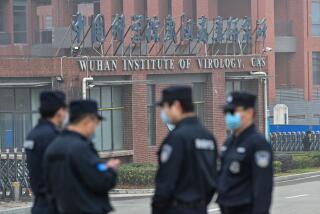‘Virus-Like Agent’ May Be New Clue to Cause of AIDS
- Share via
A mysterious “virus-like agent” detected in AIDS patients has been described in detail by a team of federal researchers, who suggest that their findings may challenge prevailing wisdom on what causes AIDS.
The researchers, at the Armed Forces Institute of Pathology and the National Institutes of Health, said the agent may represent a new infection striking people with damaged immune systems, or may play “a more fundamental role as a co-factor” in triggering AIDS.
“Our . . . data is too meager to make this distinction, but we have unequivocally demonstrated the existence of a previously unrecognized virus-like infectious agent in patients with AIDS,” they reported in the most recent issue of the American Journal of Tropical Medicine and Hygiene.
Virologists and other AIDS researchers reacted with caution to the findings, a follow-up to a brief, preliminary account by the researchers in 1986. Scientists on Tuesday described the more detailed results as provocative but not necessarily conclusive.
They pointed out that the findings have yet to be confirmed by other researchers--a crucial test of the credibility of a piece of research. Some also cited what they described as limitations in the federal researchers’ methods and data.
All said they were withholding judgment on the significance of the report.
“I think it’s very interesting, I think it deserves more attention,” said Norbert Rapoza, a virologist and senior scientist with the American Medical Assn. who has followed the research. “I think it has to be looked at more closely.”
Most leading researchers believe that AIDS is caused by the human immunodeficiency virus, or HIV. The virus is thought to gradually destroy a person’s immune system, leaving the person vulnerable to a range of infections that are eventually lethal.
Some AIDS activists and a few scientists challenge that explanation, contending that AIDS may result from a combination of forces or another virus. AIDS activists who hold that view welcomed the newly published report on Tuesday, saying that it supports their suspicions.
The federal researchers, headed by Shyh-Ching Lo of the Armed Forces Institute, originally identified the new virus-like infectious agent, called VLIA, in a single patient with Kaposi’s sarcoma, a form of cancer that affects some AIDS patients.
Using a series of sophisticated laboratory techniques, the scientists determined that the agent could infect cells. Through analysis, they also concluded that it was distinct from numerous other viruses, some of which have also been suspected of being co-factors in causing AIDS.
They then examined DNA isolated from various organs in 10 people with AIDS; in seven, they found pieces of DNA apparently similar to that of the virus-like agent. When they examined DNA from people without AIDS, they found no such similarities.
“Our findings suggest that VLIA may represent a new opportunistic infection in these severely (debilitated) patients, or an agent which plays a more fundamental role as a co-factor in the process associated with infection by HIV,” the researchers reported.
Through intermediaries, Lo declined Tuesday to discuss his findings.
The journal in which the report appeared this month is published by the American Society of Tropical Medicine and Hygiene. Virologists described the journal, mailed monthly to 3,600 specialists, as a respected forum for issues concerning tropical medicine.
All reports must be reviewed and approved in advance by experts in the field.
Virologists contacted Tuesday declined to speculate on the significance of Lo’s findings. Some also declined to be quoted by name on the subject. They said the viral agent could prove to be anything from a contributing cause of AIDS to nothing more than a contaminant.
“I’m convinced that the agent does exist,” said Rapoza, who said he has followed Lo’s work for 18 months. “I don’t think he’s faking it. He has something; he has a virus. The question is, where did it come from?”
Another prominent virologist said “it would be nice” to see additional evidence--for example, confirmation by other researchers, a good electron microscopic picture of the agent and more proof that the agent is common in AIDS patients.
Meanwhile, in separate work, U.S. scientists announced Tuesday that they have successfully modified the AIDS drug AZT in the hope of making it more potent in counteracting HIV and reducing its side-effects, such as anemia and bone marrow disorders.
Dr. Sudhir Gogu of Tulane University School of Medicine announced the development of so-called DP-AZT at a meeting of the Federation of American Societies for Experimental Biology in New Orleans. He reported “promising results” in mice cells.
AZT, also known as retrovir or zidovudine, is the only approved treatment for acquired immune deficiency syndrome on the U.S. market. Although not a cure, the drug can prolong the lives of AIDS victims by slowing the spread of infection from cell to cell.






